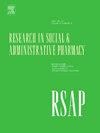结核病治疗中断风险分层预测评分模型的开发与验证。
IF 3.7
3区 医学
Q1 PUBLIC, ENVIRONMENTAL & OCCUPATIONAL HEALTH
Research in Social & Administrative Pharmacy
Pub Date : 2024-08-28
DOI:10.1016/j.sapharm.2024.08.091
引用次数: 0
摘要
背景:结核病(TB)治疗中断会带来抗菌药耐药性风险,可能导致治疗失败和死亡。在结核病护理和管理中,应对早期治疗中断的风险对于改善治疗效果和遏制疾病传播至关重要:本研究旨在确定肺结核治疗中断的风险因素,并构建一个预测评分模型,以进行客观的风险分层,从而更好地预测治疗中断:在2022年3月至2023年1月的11个月期间,在马来西亚沙捞越州的公共卫生诊所开展了一项多中心回顾性队列研究,涉及2018年至2021年期间确诊的年龄≥18岁的药物敏感性肺结核成年患者。连续或非连续累计漏服或停用结核病药物≥2 周被视为治疗中断。该模型采用分裂样本法进行开发和内部验证。多元逻辑回归分析了 18 个预定义变量,以确定结核病治疗中断的预测因素。采用Hosmer-Lemeshow检验和接收者工作特征曲线下面积(AUC)来评估模型的性能:在 2953 例病例中,三分之二(1969 例)被归入衍生队列,三分之一(984 例)被归入验证队列。阳性预测因素包括吸烟、曾接受过治疗的病例和药物不良反应,而并发糖尿病则具有保护作用。根据验证数据集,该模型具有良好的校准性(P = 0.143)和可接受的判别能力(AUC = 0.775)。以 2.5 分(满分 11 分)为临界值,灵敏度为 81%,特异度为 64.4%。低风险(0-2 分)、中风险(3-5 分)和高风险(≥6 分)三类风险分层显示的上升中断率分别为 5.3%、18.1% 和 41.3%(P 结论:该预测性评分模型有助于对患者进行评估:预测性评分模型有助于对结核病治疗中断进行风险评估,从而在早期治疗阶段对高危人群进行重点监测并制定个性化干预计划。本文章由计算机程序翻译,如有差异,请以英文原文为准。
Development and validation of a predictive scoring model for risk stratification of tuberculosis treatment interruption
Background
Tuberculosis (TB) treatment interruption poses risks of antimicrobial resistance, potentially leading to treatment failure and mortality. Addressing the risk of early treatment interruption is crucial in tuberculosis care and management to improve treatment outcomes and curb disease transmission.
Objectives
This study aimed to identify risk factors of TB treatment interruption and construct a predictive scoring model that enables objective risk stratification for better prediction of treatment interruption.
Methods
A multicentre retrospective cohort study was conducted at public health clinics in Sarawak, Malaysia over 11 months from March 2022 to January 2023, involving adult patients aged ≥18 years with drug-susceptible TB diagnosed between 2018 and 2021. Cumulative missed doses or discontinuation of TB medications for ≥2 weeks, either consecutive or non-consecutive, was considered as treatment interruption. The model was developed and internally validated using the split-sample method. Multiple logistic regression analysed 18 pre-defined variables to identify the predictors of TB treatment interruption. The Hosmer-Lemeshow test and area under the receiver operating characteristic curve (AUC) were employed to evaluate model performance.
Results
Of 2953 cases, two-thirds (1969) were assigned to the derivation cohort, and one-third (984) formed the validation cohort. Positive predictors included smoking, previously treated cases, and adverse drug reactions, while concurrent diabetes was protective. Based on the validation dataset, the model demonstrated good calibration (P = 0.143) with acceptable discriminative ability (AUC = 0.775). A cutoff score of 2.5 out of 11 achieved a sensitivity of 81 % and a specificity of 64.4 %. Risk stratification into low (0–2), medium (3–5), and high-risk (≥6) categories showed ascending interruption rates of 5.3 %, 18.1 %, and 41.3 %, respectively (P < 0.001).
Conclusion
The predictive scoring model aids in risk assessment for TB treatment interruption, enabling focused monitoring and personalized intervention plans for higher-risk groups in the early treatment phase.
求助全文
通过发布文献求助,成功后即可免费获取论文全文。
去求助
来源期刊

Research in Social & Administrative Pharmacy
PUBLIC, ENVIRONMENTAL & OCCUPATIONAL HEALTH-
CiteScore
7.20
自引率
10.30%
发文量
225
审稿时长
47 days
期刊介绍:
Research in Social and Administrative Pharmacy (RSAP) is a quarterly publication featuring original scientific reports and comprehensive review articles in the social and administrative pharmaceutical sciences. Topics of interest include outcomes evaluation of products, programs, or services; pharmacoepidemiology; medication adherence; direct-to-consumer advertising of prescription medications; disease state management; health systems reform; drug marketing; medication distribution systems such as e-prescribing; web-based pharmaceutical/medical services; drug commerce and re-importation; and health professions workforce issues.
 求助内容:
求助内容: 应助结果提醒方式:
应助结果提醒方式:


